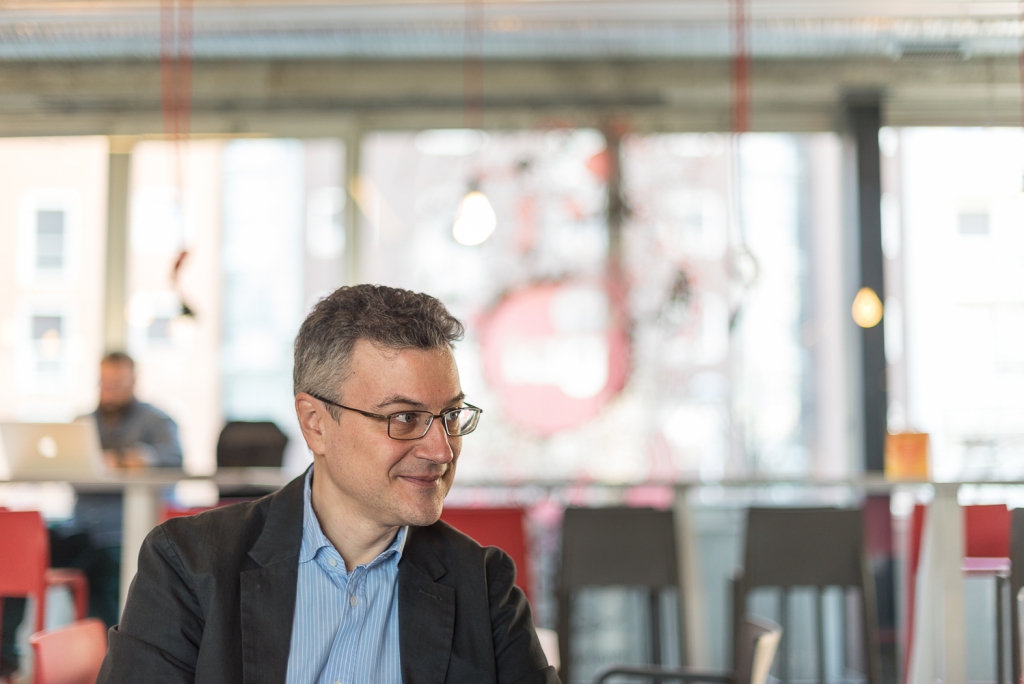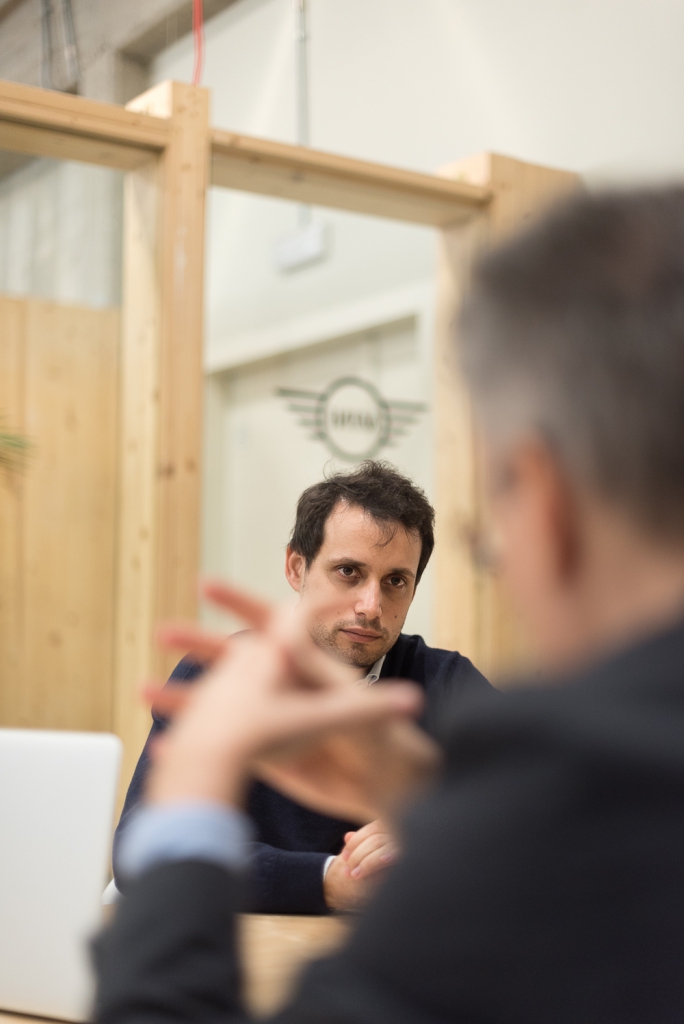«Why I left my job to start up an AI company». Interview with Conversate’s CEO Alessandro Vitale
The challenge of switching from manager to founder. The hard part of Innovation in the enterprise sector. How to keep up with new technologies and emerging professions.
We meet Alessandro Vitale at the Talent Garden Calabiana cafe, in Milan. Alessandro is the founder of Conversate, an artificial intelligence company, he is the author of the book titled “Artificial Intelligence” in the Talent Garden Innovation School series published by Egea, and is a member of the Artificial Intelligence Task Force at the Digital Agency for Italy (Agenzia per l’Italia Digitale). Alessandro’s story is interesting: at thirty-two, he left a job as a manager in the company and became an entrepreneur in the field of artificial intelligence for the enterprise market. We ask him a few questions to reconstruct the events that led to his success and to get to know his vision of the changes that artificial intelligence will bring to the world of work.

Can you explain what Conversate does and who it is aimed at?
Conversate is an artificial intelligence company. Our product is an enterprise platform, useful for creating communication systems based on conversational interfaces. I founded Conversate to provide large companies with the tools to create advanced-quality chatbots and virtual assistants. Most of the solutions on the market today allow you to create relatively simple chatbots, but our goal is to enable companies to implement ambitious projects, to create intelligent virtual assistants at the level of those developed by Google, Amazon or Facebook.
What is the path that led you to found Conversate?
I studied engineering in Bologna, then I got an MBA from the MIP Milan Polytechnic. Shortly afterwards, I joined Siemens, the Italian strategy team. I made a career in the company, becoming responsible for South-West Europe. In those years, my job was to conduct strategic analysis. I was closely following the rapid growth of companies such as Google and Amazon, which already had very high profits at the time. Just out of the dot-com crisis, Google was making profits similar to Siemens: it was clear that something significant was happening. During my research, I realised that these companies used Machine Learning techniques and artificial intelligence. Among other things, I was in charge of defining cross-selling plans for the company’s key accounts. I noticed how Amazon did the same for its users, on the e-commerce site, using recommendation algorithms. Coincidentally, some courses were created, such as the one held by Andrew Ng, then professor at Stanford, on Machine Learning. I started thinking about creating a company specialising in cross-selling algorithms dedicated to the B2B world; I wanted to bring Amazon’s innovation into the physical world of business. In 2008, I was thirty-two years old, I founded my first company, Optimist AI where “AI” stood for Augmented Intelligence: Artificial Intelligence allows the machine to perform activities instead of people, increased intelligence then increases the intelligence, productivity, efficiency and effectiveness of people. In Optimist AI, we created an excellent technology, perhaps a little ahead of schedule. I discovered that the adoption of increased intelligence involves many organisational changes: it requires changing the way of working, the system of incentives, the method of measuring results. It was very difficult to bring this type of innovation into companies, precisely because of the difficulty in implementing the necessary changes at an organisational level. This led me to found Conversate, a company specialising in chatbots: for companies, chatbots are a much easier technology to adopt.
How come at thirty-two, in a time of strong company growth, you decided to found your own start-up?
In 2008, the markets collapsed. The whole world stops and you suddenly find you have free time. I spent that time studying and reflecting on the next step of my path: continue pursuing a career in the company or pursue the desire, that I had always had to found something of my own? They say, “if you want to go far, travel in a big group, if you want to go fast, travel with the few”: in five years spent in Siemens, I had seen a very large company, with a century of history, which had given me great satisfaction but that was on a slow path. But I wanted to go fast: it was the right time, because there were new technologies to experiment with and I was convinced that I had the right ideas to do it.
What vision guided your decision to start a company in the field of artificial intelligence?
Back then, there was talk of Big Data. The first uses in this field aimed to replace simple processes, ETL (data processing) and so on, no particularly intelligent system. Simple calculations were made on large amounts of data. It was clear to me that Big Data was an element of great wealth, but it wasn’t the ultimate goal: the goal is always to be able to complete actions; to complete actions I need an element that simplifies complexity. To complete actions starting with Big Data, therefore, I needed Machine Learning and Artificial Intelligence. Technology had actually been around for a long time; the enabling element was the emergence of new channels and changes in people’s behaviour. One example: there were chatbots even in the nineties, but then people were not used to chatting. Today, people spend their days on WhatsApp. So, the chatbot, in addition to working better thanks to algorithms, also has fertile ground in people’s habits. This is one of the keys to evaluating the possible applications of artificial intelligence: will people have to change their habits? Some technological innovations require a change in behaviour, such as search engines: we had to learn how to use them, because there was nothing like them before. Chatbots, on the other hand, are different: you just have to ask them, as you would do with a person in the flesh. The same happened with cars: when they became a consumer product, we created roundabouts and traffic lights, which were not there before. I wonder if we will have to build a car so advanced that it is perfectly capable of driving in the infrastructure designed for men, or will we change the infrastructure to be able to introduce the self-guided car more quickly?
From company manager to entrepreneur. What were the biggest difficulties in this transition?
Founding a company means having to do a bit of everything, even things you had never done before. In the field of innovation, it is also necessary to understand when it’s the right time to go into the market. Optimist AI, my first company, was a few years ahead of the maturity of the market. Many companies still try to offer products similar to those we used to make, such as cross-selling systems based on artificial intelligence. I doubt the success of these initiatives, because the difficulty of introducing organisational changes has not changed over time. A few years later, with Conversate, it was all easier: in March 2016, Facebook opened Messenger, its instant messaging software, to chatbots. Users already knew how to use them, because they were used to using Messenger with their friends. In short, the market was ready and there was a lack of a suite of professional tools dedicated to companies to create advanced chatbots: I put all the experience gained in the past into Conversate, trying to quickly create an effective product that would be of value for both companies and their users.
What are the skills you are looking for in your employees?
I’m looking for people with Machine Learning and Artificial Intelligence skills. Unfortunately, there are few, many have gone to work abroad because the market is several years behind here in Italy. What’s more, it’s also quite inflated: in 2010, those who knew how to use Excel called themselves Data Scientists, today those who download an open source library call themselves Machine Learning Engineers – but they don’t always really know how things work. On the market, the roles and professions are not yet clear; sometimes I ask myself whether I should hire a person experienced in business processes and train him on the technological component, or vice versa. Often the solution is the reverse, because it is easier to teach a little business to a technician than the other way around. There is also a lack of connection figures: professionals able to understand and speak both the language of business and technology. Paradoxically, these figures, at the moment, are the scarcest on the market, but they are often the most important. From now on, in large companies, the challenge will be to introduce and manage artificial intelligence and Machine Learning tools: defining the User Experience, not only for end users, for example chatbot users, but also for the entire UX and the processes of those who will have to manage, maintain, monitor and improve these tools. The design of processes, as well as the ability to scale and manage them within the company, are very important design and research areas and very borderline.
Who is your contact person in your customer companies?
Often a new project of chatbot and artificial intelligence is created in the innovation departments. The projects that succeed best are those that are rooted in the company’s business goals. You need the strength and the will to go beyond a simple pilot project, making choices that have continuity and foresight. We have worked, for example, with UBI Banca and Prysmian: these companies have taken advantage of moments of change – respectively the acquisitions of good banks and the acquisition of General Cable – to develop a new artificial intelligence project. In both cases, we created a virtual assistant to support employees in the transition phase that companies were facing. These companies have acquired a deep knowledge of what it means to carry out a complete artificial intelligence project, from the idea to the production. Too often, “POC” (Proof of Concept) projects are excellent experiments, but they do not let you solve doubts about the actual impact of these innovations in terms of skills and processes throughout the company.
Who are the designers of chatbot systems?
The design of artificial intelligence systems is critical to guide and compensate for technology failures. For example, when designing a chatbot, it is important to define the questions to be asked to the user, in order to facilitate the work of the algorithms. The designer of these systems is a figure who was not there before. Many companies still underestimate the importance of this role. The chatbot designer works together with technicians, because the design of the interaction between man and artificial intelligence is deeply linked to technological aspects. However, creating a virtual assistant is not just a technical theme, nor is it just a design theme. Chatbots designed for marketing purposes often work very badly because they lack a real component of artificial intelligence, therefore they do not understand the requests of users, and this generates frustration among users.
Artificial intelligence is changing the world of work. New roles will be created, more will disappear. How do you create a systematic approach to lifelong learning?
Coursera has tried to offer a form of large-scale skills upgrading through MOOCs, the Massive Open Online Courses. Since then, many similar companies have arisen. Unfortunately, however, it is clear that these tools are only effective for the lucky ones who already have high-level skills. Bringing new skills to the masses of the population is still an open question. This is one of the great challenges of the future. Artificial intelligence will not replace people, but will relieve them of the simplest and most repeatable tasks. Unfortunately, many people still work exclusively in these kinds of jobs. Perhaps with artificial intelligence, we risk putting too high an entry barrier for many people who do not have the skills to retrain. Existing technological solutions, such as MOOCs, are not working for the largest and least prepared part of the population. It will be essential to find a balanced path.

